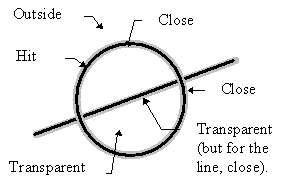
Indicates whether a point is within a given aspect of an object.
HRESULT QueryHitPoint(
DWORD dwAspect, //Requested drawing aspect
LPRECT pRectBounds, //Object bounding rectangle
POINTL ptlLoc, //Hit location
LONG lCloseHint, //Suggested distance considered close
DWORD* pHitResult //Pointer to returned hit information
);
To support hit detection on non-rectangular objects, the container needs a reliable way to ask an object whether or not a given location is inside one of its drawing aspects. This function is provided by IViewObjectEx::QueryHitPoint.
Note that since this method is part of the IViewObjectEx interface, the container can figure whether an mouse hit is over an object without having to necessarily launch the server. If the hit happens to be inside the object, then it is likely that the object will be in-place activated and the server started.
Typically, the container first quickly determines whether a given location is within the rectangular extent of an object. If the location is within the rectangular extent of an object, the container calls IViewObjectEx::QueryHitPoint to get confirmation that the location is actually inside the object. The hit location is passed in client coordinates of the container window. Since the object may be inactive when this method is called, the bounding rectangle of the object in the same coordinate system is also passed to this method, similarly to what happens in IPointerInactive::OnInactiveSetCursor.
Possible returned values include:
QueryHitPoint is not concerned by the sub-objects of the object it is called for. It merely indicates whether the mouse hit was within the object or not.
QueryHitPoint can be called for any of the drawing aspects an object supports. It should fail if the it is not supported for the requested drawing aspect.
Transparent objects may wish to implement a complex hit-detection mechanism where the user can select either the transparent object or an object behind it, depending on where exactly the click happens inside the object. For example, a transparent TextBox showing big enough text may let the user select the object behind, for example, a bitmap, when the user clicks between the characters. For this reason, the information returned by QueryHitPoint includes indication about whether the hit happens on an opaque or transparent region.
An example of non-rectangular and transparent hit detection is a transparent circle control with an object behind it (a line in the example below):

The values shown are for hit tests against the circle; gray regions are not part of the control, but are shown here to indicate an area around the image considered close. Each object implements its own definition of close but is assisted by a hint provided by the container so that closeness can be adjusted as images zoom larger or smaller.
In the picture above, the points marked "Hit", "Close" and "Transparent" would all be hits of varying strength on the circle, with the exception of the one marked "Transparent, (but for the line, close)." This illustrates the effect of the different strength of hits. Since the circle responds "transparent" while the line claims "close," and transparent is weaker than close, the line takes the hit.
An object supporting IViewObjectEx is required to implement this method at least for the DVASPECT_CONTENT aspect. The object should not take any other action in response to this method other than to return the information; there should be no side-effects.
Windows NT: Use version 4.0 or later. New for OC96.
Windows: Use Windows 95 or later. New for OC96.
Windows CE: Unsupported.
Header: Declared in ocidl.h.
IPointerInactive::OnInactiveSetCursor, HITRESULT